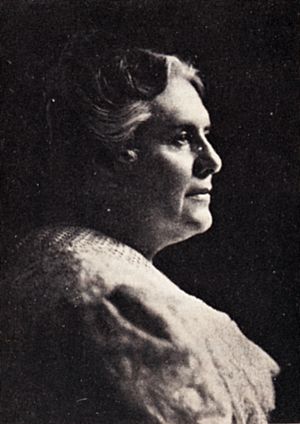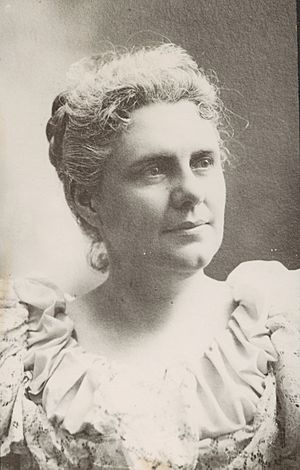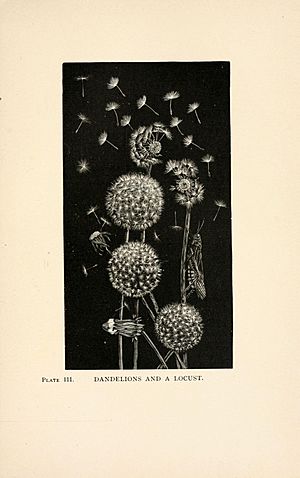Anna Botsford Comstock facts for kids
Quick facts for kids
Anna Botsford Comstock
|
|
|---|---|
 |
|
| Born | 1 September 1854 |
| Died | 24 August 1930 (aged 75) Ithaca, New York, U.S.
|
| Nationality | American |
Anna Botsford Comstock (born September 1, 1854 – died August 24, 1930) was a famous American author, illustrator, and teacher. She loved studying nature. She became the first female professor at Cornell University.
Her most famous book, The Handbook of Nature Study (1911), is over 900 pages long. It is still used today! Anna Comstock was also a talented artist and wood engraver. She drew pictures for many science textbooks, especially about insects. She often worked with her husband, John Henry Comstock. Together, they created books like The Manual for the Study of Insects (1885).
Anna Comstock worked with other experts at Cornell University. They created lessons to help people learn about and appreciate the natural world around them. She believed that loving nature would help people want to protect it.
Contents
Anna Comstock's Early Life and Education
Anna Botsford Comstock was born in a log house in Otto, New York. Her parents were Marvin and Phebe Irish Botsford. When she was three, her family moved to a farm. They grew their own food and raised animals.
Anna was the only child. Her parents thought education was very important. Her mother, Phebe, loved nature and shared this passion with Anna. They would explore the nearby woods and fields together. Anna learned the names of many flowers, birds, and trees from her mother.
In 1871, Anna went to Chamberlain Institute and Female College. This was a school in Randolph, New York. Here, she met Martha Van Rensselaer, who would become a close friend later. Anna loved literature and languages at this school. She graduated in 1873. After teaching for a year, she started at Cornell University in November 1874.
Anna Comstock's Time at Cornell University
Anna Botsford's first year at Cornell was a bit difficult. She had to take many tests to get in. She also needed help with German. She lived in a boarding house and had an active social life. Her classes included botany (the study of plants) and zoology (the study of animals).
In 1875, Anna moved into Sage College. This was a new building for women students on campus. During that winter, she took a class about insects (entomology). Her teacher was John Henry Comstock. He was just starting his career as a university lecturer.
Anna and John became good friends, and then they fell in love. They got married on October 7, 1878. After marrying, Anna stopped being a student for a while. She helped her husband with his research and drew pictures for his insect studies.
In 1881, they returned to Cornell. Anna decided to finish her degree. She earned her diploma in natural history in June 1885. She also joined the Kappa Alpha Theta sorority. In 1888, she was one of the first women chosen for Sigma Xi, an honor society for science students at Cornell.
Anna Comstock's Amazing Career
Anna Comstock spent her life drawing for her husband's lectures and books about insects. She didn't have formal art training. She would study insects under a microscope and then draw them. She even made drawings for a government report on citrus insects.
To make her drawings ready for printing, she learned wood engraving in New York City. This skill helped her create over 600 detailed pictures for books. These included Manual for the Study of Insects (1895) and Insect Life (1897). Her engravings were shown at big events like the World's Columbian Exposition in 1893. She was one of the first women to join the Society of American Wood-Engravers.
Anna Comstock also wrote and illustrated many of her own books. Some of these were Ways of the Six-Footed (1903), How to Keep Bees (1905), and The Pet Book (1914). Her most famous book, The Handbook of Nature Study (1911), was a huge success. Many people thought it wouldn't sell well, but it became a standard textbook for teachers. It has been translated into eight languages and is still printed today!
Anna Comstock is best known for teaching students and teachers to study nature outdoors. In 1895, she helped create a new way to teach nature study in public schools in New York State. She traveled, gave speeches, and trained teachers for this program.
Starting in 1897, she taught nature study at Cornell. Anna Comstock was the first female professor at Cornell University. However, it took her 20 years to get a full professorship, which happened in 1920.
Later Life and Lasting Impact
In 1922, Anna Comstock retired from Cornell. But she continued to teach during the summer. In 1923, the League of Women Voters honored her. They named her one of the twelve greatest living American women. They said she had "contributed most in their respective fields for the betterment of the world." In 1930, she received an honorary degree from Hobart and William Smith Colleges.
Anna Comstock passed away in Ithaca, New York, in 1930. In 1988, she was added to the National Wildlife Federation Conservation Hall of Fame. This recognized her efforts to protect nature. A residence hall at Hobart and William Smith Colleges is named Comstock Hall in her honor.
Her Memoir
Anna Comstock wrote a memoir about her life. It was published after she died in 1953. It was called The Comstocks of Cornell: John Henry Comstock and Anna Botsford Comstock. A new edition of her memoir was published in 2020. This new book gives a better idea of what Anna was truly like. It shares her own writings about her marriage, travels, teaching, and scientific studies.
Images for kids
See also
 In Spanish: Anna Bostford Comstock para niños
In Spanish: Anna Bostford Comstock para niños













